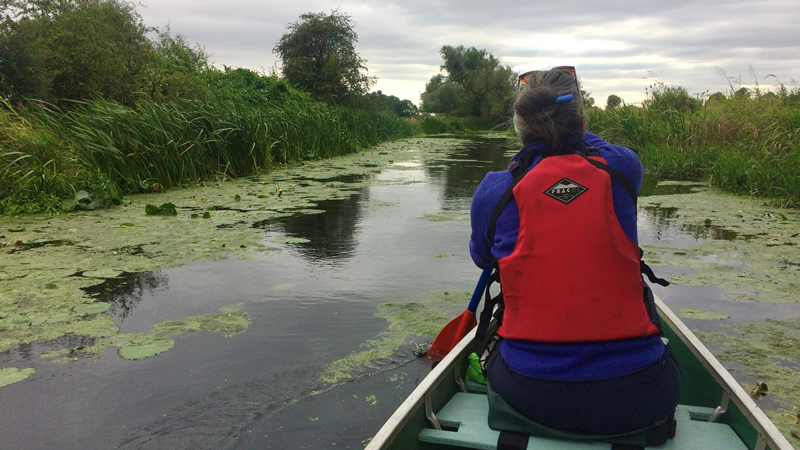Portholme Meadow, Brampton, August 2021
Jim Stevenson decided to circumnavigate this enormous flood plain meadow, thought to be the largest in the country, by canoe. This is his tale
.
The Great Ouse takes a huge loop around Portholme Meadow, making it an island that we can circumnavigate by canoe. Sometimes, when the river is thick and swollen after storms, we can paddle right across it. In spring the boggy puddle-patches that remain will attract migrating Curlews, Oystercatchers and Redshanks that will later burble and whistle their eerie calls in the northern Pennines, Scotland or even as far away as Iceland. Then the wildflowers will start to show among the grasses and we will make our annual pilgrimage to worship the chequered flowers of Snake’s-head Fritillaries and spikes of Early-purple Orchids. Corn Buntings will sing their jingle-jangle songs, Swallows and Sand Martins will swoop low over the water. The white Common Tern ‘sea swallows’ with their long-streamers for tails, black crowns and blood-red bills, will take shortcuts across the grassland to carry tiddlers to their chicks.

Today the meadow is silent and we can only hear the swish and drip of our paddles as we take a back-channel though lesser meadows. These pastures have not been cut for hay for some years now, so rough purple thistles and tall yellow Ragworts have taken over. Even so, cattle find rich grazing, especially at the water’s edge and along the lushness of the wet ditches.
We flush a Heron from the bank and a Kingfisher streaks by as we run aground on a gravel bar to watch hundreds of small silver fish swarm across the stones. They are mostly Bleak (a little roach-like fish) and Minnows. Under the Water-cress at the edge of the channel there will be Sticklebacks, Loaches and Bullheads too. It’s a perfect hunting ground for that Kingfisher and easy wading for the Heron.
Our fishy fascination is disrupted by a huge splash, then another as a herd of bullocks wade into the stream to take a very close look at us. We push off through two-metre tall stands of dark green Bulrushes that look like giant versions of the hard rushes that grow in wet pastures. We enter a pool, fringed with more rushes, reeds and great spikes of Purple Loosestrife. Here is Flowering Rush, which isn’t a rush at all, but a glorious waterside flower with an umbrella-head of large pink-red three-petalled flowers. It grows out of the water in clumps by the moorings along the bank. Also with three petals, this time white, the Water Arrowhead is named for its triangular leaves. Down here in the canoe we can marvel at the detail in all these special plants that grow with their feet in the water.
We can’t peek over the bank into Portholme today because of a fringe of tall Stinging Nettle, Gypsywort, Willow-herb, Orange Balsam and Hemp Agrimony, but stands of purple Water-Mint and blue Water Forget-me-not creep down the banks to greet us. Big blue Emperor Dragonflies dash among the stems and smaller Ruddy Darters sun themselves on the tips of the flowers and on the reeds. Metallic-blue Banded Demoiselles crowd on the gunwale of our canoe.
Now the low sun is warm on our backs and our dreamy, hazy eyes allow the scene to liquify into an eddying swirl of air, water, plants and insects, punctured by flashing bright refracted strobes of blinding sliver sunlight. The slow current drifts us silently along and we remain mesmerised until families of Africa-bound Swallows push through the soft air and splat onto the water to drink. It’s time for us to leave too.
Jim Stevenson
You can learn more about the wildlife of Portholme Meadow from Dr Pat Doody’s article here: Visiting the Area. You can also see photographs of some of the plants mentioned by Jim in Ian Dobson’s Sight and Sound piece here: Riverside Rapture

